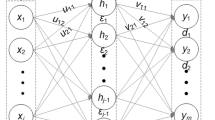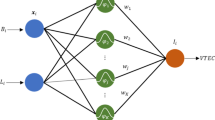Abstract
Machine learning techniques which are about the construction and study of system that can learn from data are combined with many application fields. A method on ionospheric total electron content (TEC) mapping is proposed based on radical basis function (RBF) neural network improved by Gaussian mixture model (GMM). Due to the complicated ionospheric behavior over China, GMM is used to determine the center of basis function in the unsupervised training process. Gradient descent is performed to update the weights function on a sum of squared output error function in the supervised learning process. The TEC values from the center for orbit determination in Europe (CODE) global ionospheric maps covering the period from 2007 to 2010 are used to investigate the performance of the developed network model. For independent validation, the simulated TEC values at different latitudes (20°N, 30°N and 40°N) along 120°E longitude are analyzed and evaluated. The results show that the simulated TEC from the RBF network based model has good agreement with the observed CODE TEC with acceptable errors. The theoretical research indicates that RBF can offer a powerful and reliable alternative to the design of ionospheric TEC forecast technologies and thus make a significant contribution to the ionospheric modeling efforts in China.
Similar content being viewed by others
References
Schaer S. Mapping and predicting the Earth’s ionosphere using the Global Positioning System. Dissertation of Doctoral Degree. Bern: Astronom Inst, Univ Bern, 1999
Liu J B, Chen R Z, Wang Z M, et al. Spherical cap harmonic model for mapping and predicting regional TEC. GPS Solutions, 2011, 15: 109–119
Wang S K, Jiao P N, Liu W. Improved kriging technique of ionospheric parameter foF2 instantaneous mapping. Chin Radio Sci, 2006, 21: 167–171
Huang Z, Yuan H. Ionospheric refraction correction based on spatial statistic for China region. Chin J Space Sci, 2012, 32: 209–215
Sayin I, Arikan F, Arikan O. Regional TEC mapping with random field priors and kriging. Radio Sci, 2008, 43: RS5012
Wan W X, Ning B Q, Liu L B, et al. Nowcasting the ionospheric total electron content over China. Prog Geophys, 2007, 22: 1040–1045
Harnendez-Pajares M, Zornoza J, Subirana J S, et al. EGNOS test bed ionospheric corrections under the October and November 2003 storms. IEEE Trans Geosci Remote Sens, 2005, 43: 2283–2293
Tan S S. Development and thought of compass navigation satellite system. J Astronautics, 2008, 29: 391–396
Tan S S, Zhou B, Guo S T, et al. Research on COMPASS navigation signals of China. Chin Space Sci Tech, 2011, 31: 9–14
Kong Q Y, Liu W, Fan J M, et al. On the prediction of foF2 using artificial neural networks. Chin J Geophys, 2009, 52: 1438–1443
Yue X A, Wan W X, Liu L B, et al. Applying artificial neural network to derive long-term foF2 trends in the Asia/Pacific sector from ionosonde observations. J Geophys Res, 2006, 111: A10303
Yilmaz A, Akdogan K E, Gurun M. Regional TEC mapping using neural networks. Radio Sci, 2009, 44: RS3007
Habarulema J B, McKinnell L A, Cilliers P J, et al. Application of neural networks to South African GPS TEC modeling. Adv Space RES, 2009, 43: 1711–1720
Sarma A D, Madhu T. Modelling of foF2 using neural networks at an equatorial anomaly station. Current Sci, 2005, 89:1245–1247
Liu L, Wan W, Chen Y, et al. Solar activity effects of the ionosphere: A brief review. Chin Sci Bull, 2011, 56: 1202–1211
Reynolds D. Gaussian Mixture Models [Internet], Encyclopedia of Biiometric Rcognition. http://www.ll.mit.Edu/mission/communicat-ions/ist/publications/0802ReynoldsBiometrics-GMM.pdf
Author information
Authors and Affiliations
Corresponding author
Rights and permissions
About this article
Cite this article
Huang, Z., Yuan, H. Research on regional ionospheric TEC modeling using RBF neural network. Sci. China Technol. Sci. 57, 1198–1205 (2014). https://doi.org/10.1007/s11431-014-5550-0
Received:
Accepted:
Published:
Issue Date:
DOI: https://doi.org/10.1007/s11431-014-5550-0




